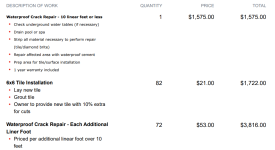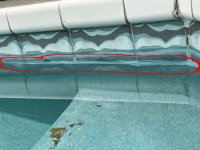Hi All,
I believe this pool is about 30 years old. I just moved in less than two years ago. The pool needs to be resurfaced, but leak inspector is saying: "Previously patched tiles throughout the pool border tile. Border tile also has multiple areas that are starting to open up and could potentially leaks in the future. Recommend resealing tile line."
Quote for doing this work is attached.
I guess I am just looking for advice here. We knew coming into the house the pool was due for a resurface. I'm wondering if what this company is saying they will do is the right thing to do. Also wondering if I should go about this in a different order. If they were to come do the repair first, they would remove and replace with new tile after fixing the leaks. I had a concrete company come in a few months ago and fill in under deck with foam as parts of the deck were apparently hallow underneath.
The temporary patch applied definitely corrected the leak as I was losing a large amount of water per day.
Thanks for any advice.
I believe this pool is about 30 years old. I just moved in less than two years ago. The pool needs to be resurfaced, but leak inspector is saying: "Previously patched tiles throughout the pool border tile. Border tile also has multiple areas that are starting to open up and could potentially leaks in the future. Recommend resealing tile line."
Quote for doing this work is attached.
I guess I am just looking for advice here. We knew coming into the house the pool was due for a resurface. I'm wondering if what this company is saying they will do is the right thing to do. Also wondering if I should go about this in a different order. If they were to come do the repair first, they would remove and replace with new tile after fixing the leaks. I had a concrete company come in a few months ago and fill in under deck with foam as parts of the deck were apparently hallow underneath.
The temporary patch applied definitely corrected the leak as I was losing a large amount of water per day.
Thanks for any advice.











